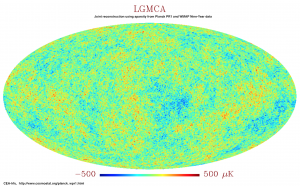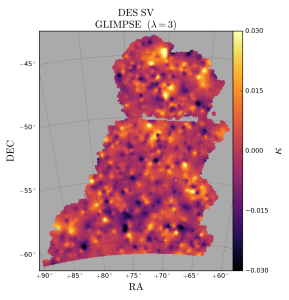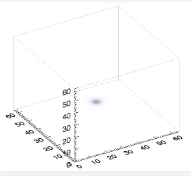Research
RESEARCH IN COSMOLOGY
- Weak Lensing:
- 2D mass mapping:
Using both shear and flexion, we have shown how very high resolution convergence maps can be reconstructed (Lanusse et al, 2016). For example, Glimpse was used to reconstruct the mass distribution in the Abell 520 merging galaxy cluster system using Hubble Space Telescope observations (Peel et al, 2018). Glimpse has also been used to map the matter density field of the Dark Energy Survey (DES) Science Verification (SV) data (Jeffrey et al, 2018). More details are available here. We have also developed a new approach, based on machine learning, which looks very promising. Using this method, we made the first reconstruction of dark matter maps from weak lensing observational data using deep learning (Jeffrey et al, 2020). More details are available here.
- The 3D tomographic mass mapping:
Underlying the link between weak lensing and the compressed sensing theory, we have proposed a completely new approach to reconstruct the dark matter distribution in three dimensions using photometric redshift information (Leonard, Dupe et Starck, 2012; Leonard, Lanusse et Starck, 2014), and we have shown we can estimate with a very good accuracy level the mass and the redshift of dark matter haloes, which is crucial for unveiling the nature of the Dark Universe (Leonard et al, 2015). More details are available here.
- Point Spread Function Modeling: For weak lensing shear measurements to be useful for cosmological studies, it is also necessary to model properly the point spread function (PSF) of the instrument. In the case of the Euclid project, this PSF is subsampled, and we have proposed a method (Ngolè, Starck et al, A&A, 2014; Ngolè, Starck et al, 2016) to achieve surperresolution, which will increase the cosmological constraining power of Euclid significantly. See here for more details. We have also used optimal transport technique to take into account the wavelength dependancy of the PSF (Ngolè et Starck, A&A, 2017; Schmitz et, 2018, Schmitz et al, 2020).
- 2D mass mapping:
- Cosmic Microwave Background (CMB): the cleanest CMB map. The cosmic microwave background (CMB) is a relic radiation, which was emitted 370,000 years after the Big Bang at the epoch of recombination. This is when our Universe became neutral and transparent. The CMB radiation has travelled the Universe since decoupling and its precise measurement is critical to observational cosmology.
 Using both WMAP and Planck PR1 data, we have reconstructed an extremely clean CMB map. A more detailed description can be found here. The same method has been used on Planck and PR2 data (Bobin et al, 2016). We have shown that large scale analysis does not require masking anymore when using our estimated CMB map (Rassat et al, 2014), and that CMB large scales are compatible with the standard l-CDM cosmological model (Rassat et al, 2014). More details can be found here. Finally, we have estimated the primordial power spectrum using our PRISM method on both WMAP9 (Paykari et al., A&A, 2014) and Planck data (Lanusse et al., A&A, 2014) and we find no significant departure from the Planck PR1 best fit.
Using both WMAP and Planck PR1 data, we have reconstructed an extremely clean CMB map. A more detailed description can be found here. The same method has been used on Planck and PR2 data (Bobin et al, 2016). We have shown that large scale analysis does not require masking anymore when using our estimated CMB map (Rassat et al, 2014), and that CMB large scales are compatible with the standard l-CDM cosmological model (Rassat et al, 2014). More details can be found here. Finally, we have estimated the primordial power spectrum using our PRISM method on both WMAP9 (Paykari et al., A&A, 2014) and Planck data (Lanusse et al., A&A, 2014) and we find no significant departure from the Planck PR1 best fit.
- Spatial/Color Distribution of Galaxies:
- New data require new representations. We have investigated benefits of performing a full 3D Fourier-Bessel analysis of spectroscopic galaxy surveys, such as the Euclid spectroscopic survey, compared to more traditional tomographic analysis. We have shown that the 3D analysis optimally extracts the information and is more robust to uncertainties on the coupling between the galaxies and the dark matter (Lanusse, Rassat and Starck, A&A, 2015).
- Late type/Early type galaxy separation: We have also shown how sparsity can help to separate automatically early type galaxies from late type galaxies, using multichannel data set (Joseph et al, A&A, 2016). Such a method could be extremely useful for Strong Lensing. See here for more details.
RESEARCH IN SIGNAL PROCESSING/STATISTICS/LEARNING
- Machine Learning: We have investigated how a convolutional neural network coud help to identify distinct cosmological scenarios based on the weak-lensing maps they produce. Modified gravity models with massive neutrinos can mimic the standard concordance model in terms of Gaussian weak-lensing observables, limiting a deeper understanding of what causes cosmic acceleration. We demonstrate that a network trained on simulated clean convergence maps, condensed into a novel representation, can discriminate between such degenerate models with 83%-100% accuracy. Our method outperforms conventional statistics by up to 40% and is more robust to noise (Peel et al, 2019).
- Radio-Interferometry Image Reconstruction: a very cool result !

Sparse recovery allows us to reconstruct an image with a resolution increased by a factor two (Garsden, Girard, Starck, Corbel et al, A&A, 2015). This has been confirmed by comparing two images of the Cygnus A radio source, the first from the LOFAR instrument and reconstructed using sparsity, and the second one from Very Large Array at a higher frequency (and therefore with a better resolution). The contour the VLA image matches perfectly the high resolution features that can be seen in the LOFAR color map image. More details here.
- Blind Source Separation: Exceptional results are obtained when sparsity is used to recover sources from a set of multichannel observations, each channel containing a mixture of the different sources (classic BSS problem). This framework was also extended so as to deal with non-negative mixtures of non-negative sources (non-negative matrix factorization, NMF, (Rapin, Bobin, Larue, Starck, IEEE Trans. on Signal Processing, 2013) and (Rapin, Bobin, Larue, Starck, SIAM Journal on Imaging Sciences, 2014; Rapin et al, Signal Processing, 2016). In addition to the CMB, it was also shown that sparse BSS is extremely efficient to recover the epoch of reionization (EoR) signal (Chapman et al, MNRAS, 2013), which is an extremely low SNR signal informing us about the Universe's dark ages end with the formation of the first galaxies.
- Sparse Representations: Curvelets and Morphological Component Analysis are there to detect properly supernovae in the SuperNova Legacy Survey (SNLS) (Moller et al, A&A 2015). See also our review on 3D sparse representation (Lanusse, Starck, Woiselle and Fadili, Advances in Imaging and Electron Physics , Academic Press: Elsevier Inc, 2014).
- Dictionary Learning: (Beckouche, Starck and J. Fadili, A&A, 2013; Sureau et al, A&A 2019).
- Inpainting: Inpainting can also be done on the Sphere (Starck, Rassat, and Fadili, A&A, 2013).
- Discussion on Bayes versus sparsity in cosmology (Starck, Donoho, Fadili and Rassat, A&A, 2013).
- See more on CosmoStat web page..

